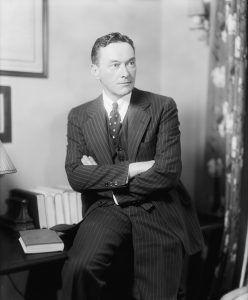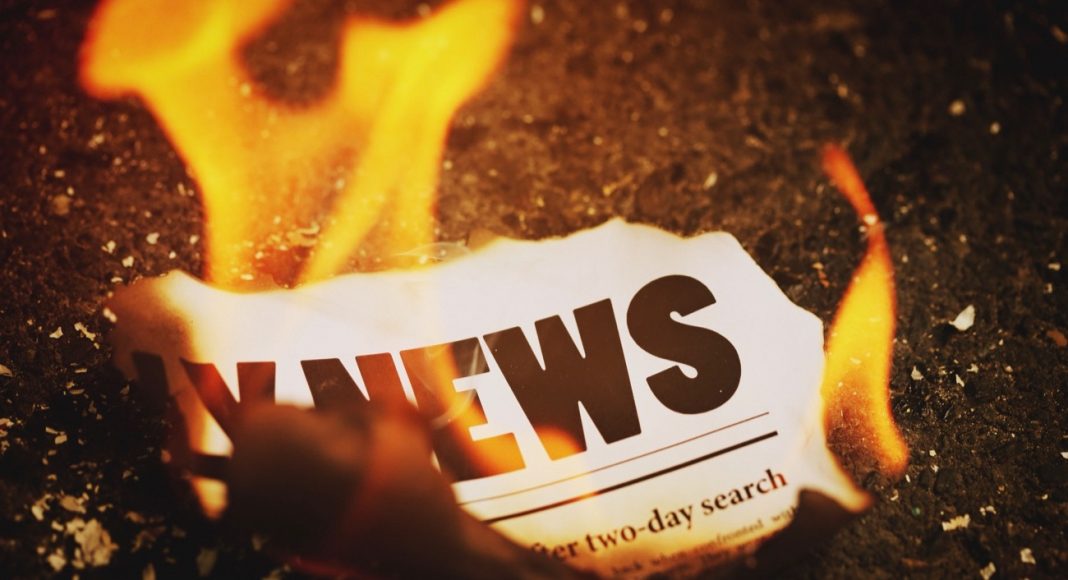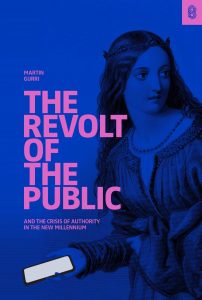At a time of information overabundance, journalism has lost its purpose. Newspapers, traditionally the keepers of journalistic flame, are going away. What does the future hold for the press? Likely a shift away from reporting toward interpretation.
Editor’s note: The following article is based on a talk given to participants of the Stigler Center’s Journalists in Residence program in November 2021.
The constitutions of democratic countries guarantee freedom of the press. Beyond that, there’s very little in them about journalism—nothing in the US Constitution, for example. Yet the self-image of journalists is that their work is essential to the survival of democracy: Journalists inform the public on important questions, they tell truth to power; without the Washington Post to keep the lights on, democracy dies in darkness.
In 1983, when the Reagan administration invaded the island of Grenada but kept reporters out, John Chancellor, anchorman of NBC television news, was enraged by this decision. Journalists, Chancellor said, were “the people’s representatives.” Media theorist Andrey Mir calls this the “myth of newspapers.” I sometimes call it the ideology of news.
In reality, of course, the news is an industry—a profit-making business. Jeff Bezos, who owns the Washington Post, is one of the richest people in the world—but Bezos still expects the Post to make money. Even the BBC, a public broadcaster funded by a television fee, sells its news programs to foreign distributors for hundreds of millions of dollars.
In the US and many other countries, what was sold for profit wasn’t the news—it was eyeballs to advertisers. In the crudest material sense, journalists wrote not to keep democracy from dying in darkness but to attract an audience that could be sold to Coca-Cola and General Motors.
That explains much of the content of news: fires and various disasters, crime, conflict, the cult of the movie star and the celebrity. It also explains the strange style of traditional journalism, with its impersonal voice and arbitrary division of content between factual reports and opinion. The objective was to keep the audience herded into a happy consumerist mass.
The 20th century was the golden age of this business model. Newspapers consolidated into local monopolies, news magazines proliferated, journalists were hired to staff growing newsrooms and foreign bureaus. Information was scarce—that made it valuable. I worked at the CIA section that looked at global media. When I was a young analyst, the volume of information was a trickle. If you owned any piece of it, you could attract those profitable eyeballs.
That day is done. The last couple of decades have been one prolonged catastrophe for the news industry. In the US, 2000 newspapers have closed since 2004. Newsroom jobs have fallen by 57 percent since 2008, with more than 16,000 journalists losing their jobs in the year 2020 alone. This American disaster has been replicated around the world.
What happened? I think we all know. The digital tsunami happened. Since the turn of the century, that tsunami has been battering every human institution in the world. The volumes are unprecedented. The information produced in 2001 doubled that of all previous history, going back to the cave paintings and the dawn of culture. 2002 doubled 2001. A business model formed to exploit information scarcity just doesn’t work in an age of overabundance.
Today, information as such has little value. Empowered by digital platforms, the public controls the commanding heights over the information landscape, and the public, it turns out, is very angry at the elites who manage those hierarchical 20th-century institutions—particularly angry at the news media. Meanwhile, advertisers have fled online, mostly to Facebook and Google.
It is within this background—this uproar of digital noise and institutional failure—that we must answer the question of journalism’s relationship to democracy and capitalism.
Jonathan Rauch
The first thinker I want to consider in this context will probably be the most congenial. In June of this year, Jonathan Rauch published a book titled The Constitution of Knowledge: A Defense of Truth. Rauch is a scholar, author, and senior fellow at the Brookings Institution—but he considers himself to be a “professional journalist.”
In the struggle between the public and the elites, Rauch represents the best of the elites. The Constitution of Knowledge, as its subtitle implies, is about much more than journalism—a powerful and erudite defense of the old institutions. Rauch wants to protect the truth-seeking process from the likes of Donald Trump, Vladimir Putin, cancel culture, misinformation, and so forth.
According to Rauch, journalists belong to what he terms the “reality-based community,” whose judgments constitute the shared truths needed in a democratic society. What does that mean? That journalists are disinterested truth-seekers. That they are part of a social network that follows certain rules and behaviors extracted, in part, from liberalism and, in part, from science.
Rauch compares the process that journalists follow as part of the reality-based community to the Socratic method: every fact is questioned, every assumption is criticized, every authority is rejected. The newsroom becomes a sort of extended Socratic dialogue, whose output is the closest available approximation of truth.
“I became a journalist,” Rauch writes, “by being forced outside of myself. From my very first steps into the world of journalism…I was thrust into contact with the world outside my own head… Facts were gathered from interviews and sources; analysis was checked with experts; every sentence was edited, copy-edited, and often fact-checked; tipsters suggested story ideas, sources waved me off bad leads, and challenges to my claims percolated in conversations within the newsroom and outside of it.”
Rauch goes on to say: “The sense of having joined something much greater than myself, and of swearing allegiance to the exacting standards of a great tradition, made the enterprise of journalism appealing and compelling to me…”
I think we can agree that this describes the Platonic ideal of journalism rather than the empirical reality of the business. That’s generally Rauch’s approach. He knows perfectly well that journalism is trapped in a moment of economic weakness and moral confusion. That’s why he wrote The Constitution of Knowledge, which is, at bottom, a call for a return to first principles. In principle, as he explicitly states, journalism must be based on truth.
As I said, Rauch is an elitist. He has nothing good to say about the digital world. He has nothing much to say, either, about how the old institutions can survive the crisis of authority that is a consequence of the digital challenge. Although his book was published this year, his voice seems to reach us like an echo from the last century.
Besides journalists, Rauch’s reality-based community is composed of scientists, academics, lawyers, and bureaucrats. It is, he says, “fundamentally a professional network, and its members are overwhelmingly professionals seeking to persuade other professionals.” No room there for Facebook or Twitter—very little space for the ordinary person, the amateur.
If we tried to create in a laboratory the typical member of Rauch’s reality-based community, I feel reasonably certain that person would be earnest, honest, intelligent, and highly educated—and would look remarkably like Jonathan Rauch.

Walter Lippmann
In 1922, almost exactly a century before The Constitution of Knowledge came out, Walter Lippmann published a book titled Public Opinion (1922). Lippmann, as I hope you all know, was one of the most interesting American political thinkers of the 20th century—but he was also a journalist and an editor. He founded The New Republic and ran it for many years. Public Opinion is Lippman’s finest work: it’s the source of several major academic disciplines, including media studies. For anyone connected to journalism, or even interested in the subject, it’s mandatory reading.
Lippmann considered the question of how the news media influences public opinion and its consequent impact on democratic politics. He was not an idealist. I would say he was a pessimist. He had been imprinted by his experience in World War I, in which he had participated in the invention of mass propaganda. He believed that millions of minds had been manipulated by that propaganda, and he wondered whether the same thing was happening in peacetime.
The news business, Lippmann concluded from his experience, did not deal in facts. It dealt in crude stereotypes that filled in the vast empty spaces in the knowledge of the average citizen. It had the power to paint the pictures inside people’s heads. Naturally, these stereotypes were manipulated by politicians and corporations to sway a helpless public in their favor. The theory of what Lippmann called the “omni-competent citizen,” which he believed was the foundation of American democracy, had been proven false by mass media.
Note that you will find in Public Opinion a treatment of the dilemma of free speech versus “fake news,” 94 years before the 2016 election. That’s pretty remarkable.
For Lippmann, the newsroom is nothing like a Socratic dialogue—it’s more like a factory floor, churning out a product for the masses. His perspective is that of the chief editor. “The editor,” he writes, “deals with…bulletins. He sits in his office, reads them, rarely does he see any large portion of the events themselves. He must…woo at least a section of his readers every day, because they will leave him without mercy if a rival newspaper happens to hit their fancy. He works under enormous pressure, for the competition of newspapers is often a matter of minutes… Without standardization, without stereotypes, without routine judgments, without a fairly ruthless disregard of subtlety, the editor would soon die of excitement.”
In the most famous passage of Public Opinion, Lippmann comes to this un-Jonathan Rauch-like judgment: “The hypothesis, which seems to me the most fertile, is that news and truth are not the same thing, and must be clearly distinguished. ”The function of news, he goes on to say, is to “signalize an event.” At its best, the news media was “the servant and guardian of the institutions.” Lippmann was a supreme elitist: like Plato, he believed that a modern democratic nation could only be ruled by a class of wise experts.
But what about truth? The function of truth, Lippmann wrote, “is to bring to light the hidden facts, to set them into relation with each other, and make a picture of reality on which men can act.” Truth, in other words, is not a function of reporting but of analysis—of understanding. I promise you I will return to this before I’m done.
“THE PUBLIC, IN SUCH A CHAOTIC ENVIRONMENT, CRAVES COMPREHENSION, NOT NEWS REPORTS. ONE OF THE INSTITUTIONS I SEE SPROUTING UP IS THAT OF THE NEW MEDIATOR: PEOPLE WHO STAND BETWEEN THE PUBLIC AND THE INFORMATION MADNESS, AND TRY TO MAKE SENSE OF THE LATTER.”
Andrey Mir
I want to turn now to Andrey Mir’s book, Postjournalism, which takes us away from abstract disputes about what a newsroom is or is not and plunges us into the rant and chaos of the digital world. Mir (born Miroshnichenko), a Russian émigré currently living in Toronto, is a breathtakingly original thinker and, in my judgment, the most profound analyst of media today.
Postjournalism looks at the destruction of traditional journalism in a way that Rauch did not and Lippmann could not (since he didn’t experience it). The old business model has been smashed to bits, and, like Humpty Dumpty, can’t be put back together again. The great digital whales like Google and Facebook have swallowed all the advertisers—they’re not coming back either. The public has no need for the news—or rather, the public is chased and overwhelmed by the news. The idea of going to a daily newspaper for something called “the news” is quaint and obsolete.
So what happens to newspapers? Postjournalism is subtitled The Death of Newspapers. Many have died already (remember the dire numbers mentioned earlier) but a few famous names—the New York Times and Washington Post, for instance—have embraced a radically new business model suited to an age of information overabundance. They are attempting, Mir says, to commodify polarization. Old journalism pretended to objectivity and avoided controversy: it wanted happy consumers. The post-journalistic style is accusatory and apocalyptic: it wants angry citizens who wish to be validated in their political opinions. Today, according to Mir, you subscribe to the New York Times as you would join a church with a fundamentalist creed.
At the heart of this transition stands the figure of Donald Trump. Trump became the Beast of the Apocalypse to post-journalism, used to terrify his opponents into subscribing. While Trump was president, the strategy worked. Before his candidacy, the New York Times’ digital subscriptions stood at under a million and flatlining. By the 2020 election, that number had grown to between 5 and 7 million, depending on who is talking.
In Mir’s words, “Trump made the American mainstream media great again.” At the same time, this strategy handed Trump, free of charge, unprecedented levels of media resources and exposure, which to a large extent accounted for his political success.
It is within this framework that we return to the dilemma of fake news. Fake news was the media’s explanation for its failure to see Trump coming, much less winning. The story told was that clever Russians, manipulating false information on Facebook—that Hillary Clinton was dying of some terrible disease, for example—handed Trump the election. Trump, of course, soon turned the tables and regularly mocked the “fake news media.”
Fake news, in my opinion, is a function of the loss of authority in the digital age of the class that once mediated between the public and reality, which obviously includes journalists. But the important point that Mir makes, and I agree with, is that fake news is by no means restricted to the web or social media. Most elites consider the internet to be the mother of lies. That’s not wrong. The incentive in a crowded environment is to be the loudest and most aggressive voice if you want to be heard at all, and the truth is often an obstacle.
But the same incentive applies to the news media. The New York Times published something like 3,000 stories over two-plus years on the Trump-Russia scandal. In virtually every one of these stories, it was at least implied that Trump or his allies were guilty of collusion. When Trump was cleared by the Mueller Report, the Times took back nothing; it just moved on to the next polarizing controversy. Why not? During those two-plus years, digital readership had increased by several million. Post-journalism, please recall, is a business model.
The incentive to commodify polarization, Mir insists, affects every corner of the information landscape. Social media algorithms exploit political rants to generate engagement. News producers like the New York Times and Fox News exploit the public’s fears and anxieties to build an audience that resembles a religious congregation. The difference is one of scale: Facebook has more than 2 billion users. The Times, with by far the largest online readership of any newspaper, barely tips 7 million. Meanwhile, Trump is gone and the “Trump bump” is receding.
Mir believes the newspaper as an art form will disappear by the mid-2030s. He believes journalism, as we once knew it, is already gone. And, as you might expect, he’s not terribly optimistic about the future of liberal democracy.
Conclusion: Will Journalism Soon Go Extinct Like the Dodo and the Dinosaurs?
I’m going to be brutally honest. I agree with Mir: journalism has lost its purpose in a time of information overabundance. The newspapers are going away. That’s fact, not speculation. And the newspapers were the keepers of the journalistic flame. No doubt a few will remain, proud old names subsidized by governments or billionaires—but they will be mummified relics of the 20th century, like Lenin in his tomb.
The word media means “in the middle.” Journalists aspired to stand between the public and the facts of the world. Today, however, we know that the facts are virtually infinite in number and incoherent in pattern. The digital dispensation resembles the Tower of Babel: an uproar of mutually unintelligible voices. Mainstream media brands like the New York Times or CNN just add to the din.
The public, in such a chaotic environment, craves comprehension, not news reports. One of the institutions I see sprouting up is that of the new mediator: people who stand between the public and the information madness, and try to make sense of the latter. These mediators are sometimes connected to news organizations but they are more likely to be independent actors, often working on platforms like Substack and depending on their own audience to make a living.
Is this the wave of the future? Who knows? My point is that the need for mediation has pivoted from reporting to interpretation. Let’s think back to what Walter Lippmann wrote about the function of truth: “to bring to light the hidden facts, to set them into relation with each other, and make a picture of reality on which men can act.” That may be the next business model for journalism.
Learn more about our disclosure policy here.







